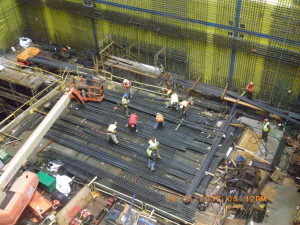Roughly two weeks before annual National Stand-Down Week (May 2-6), New York’s Appellate Division,  Second Department, in Vitale v. Astoria Energy II, LLC, affirmed a trial court’s dismissal of a worker’s personal injury claim resulting from a fall at a construction site. Specifically, the Appellate Division held that Vitale failed to create an issue of fact as to whether an alleged dangerous condition on a construction project presented an elevation-related hazard in accordance with New York’s Scaffold Law – Labor Law §§ 240(1) and 241(6). Labor Law § 240(1) was designed to prevent elevation-related risks, and holds owners and contractors absolutely liable (without consideration of the worker’s comparative fault) in the event of a statutory violation that causes an elevation-related injury. Labor Law § 241(6) imposes vicarious (but not absolute) liability upon owners and contractors for a violation of the Industrial Code that causes a worker’s injury, but allows consideration of comparative negligence.
Second Department, in Vitale v. Astoria Energy II, LLC, affirmed a trial court’s dismissal of a worker’s personal injury claim resulting from a fall at a construction site. Specifically, the Appellate Division held that Vitale failed to create an issue of fact as to whether an alleged dangerous condition on a construction project presented an elevation-related hazard in accordance with New York’s Scaffold Law – Labor Law §§ 240(1) and 241(6). Labor Law § 240(1) was designed to prevent elevation-related risks, and holds owners and contractors absolutely liable (without consideration of the worker’s comparative fault) in the event of a statutory violation that causes an elevation-related injury. Labor Law § 241(6) imposes vicarious (but not absolute) liability upon owners and contractors for a violation of the Industrial Code that causes a worker’s injury, but allows consideration of comparative negligence.
Vitale was injured at a construction site while working as a survey engineer, confirming the accuracy of the location of certain anchor bolts. In order to do so, Vitale had to walk across the top of a rebar grid. The rebar grid had square openings, which measured at most 12″ by 12″. While walking across the top of the rebar grid, Vitale lost his balance, causing his leg to fall through one of the square openings, up to his groin, resulting in his injuries. Vitale alleged causes of action under New York Labor Law § 240(1) and 241(6) premised on an alleged industrial violation of 12 NYCRR 23-1.7(b)(1)(i) governing “hazardous openings.”
According to the Appellate Division, the trial court properly dismissed Vitale’s Labor Law § 240(1) cause of action, because the openings of the grid were not of a dimension that would have permitted Vitale’s body to completely fall through, and therefore did not present an elevation-related hazard to which § 240(1) applies. Similarly, it concluded that the trial court properly dismissed Vitale’s § 241(6) cause of action because 12 NYCRR 23-1.7(b), which requires a “substantial cover” or a safety railing for a hazardous opening, does not apply to openings that are too small for a worker to completely fall through.
Even if there was no elevation-related hazard or statutory violation under New York law, contractors should take care to have appropriate safety and fall protection measures in place. Regular toolbox talks can help maintain a safe work environment by educating employees on safety procedures and equipment that apply to their work, and ensure that supervisors follow and enforce safe work practices.
Additional Source: It’s Time for a Toolbox Talk
Photo: MTA Capital Construction…, CM013 – Building West Wall Rebar Grid (8-15-2012) – Taken Aug. 15, 2012 – Creative Commons
 Gravel2Gavel Construction & Real Estate Law Blog
Gravel2Gavel Construction & Real Estate Law Blog